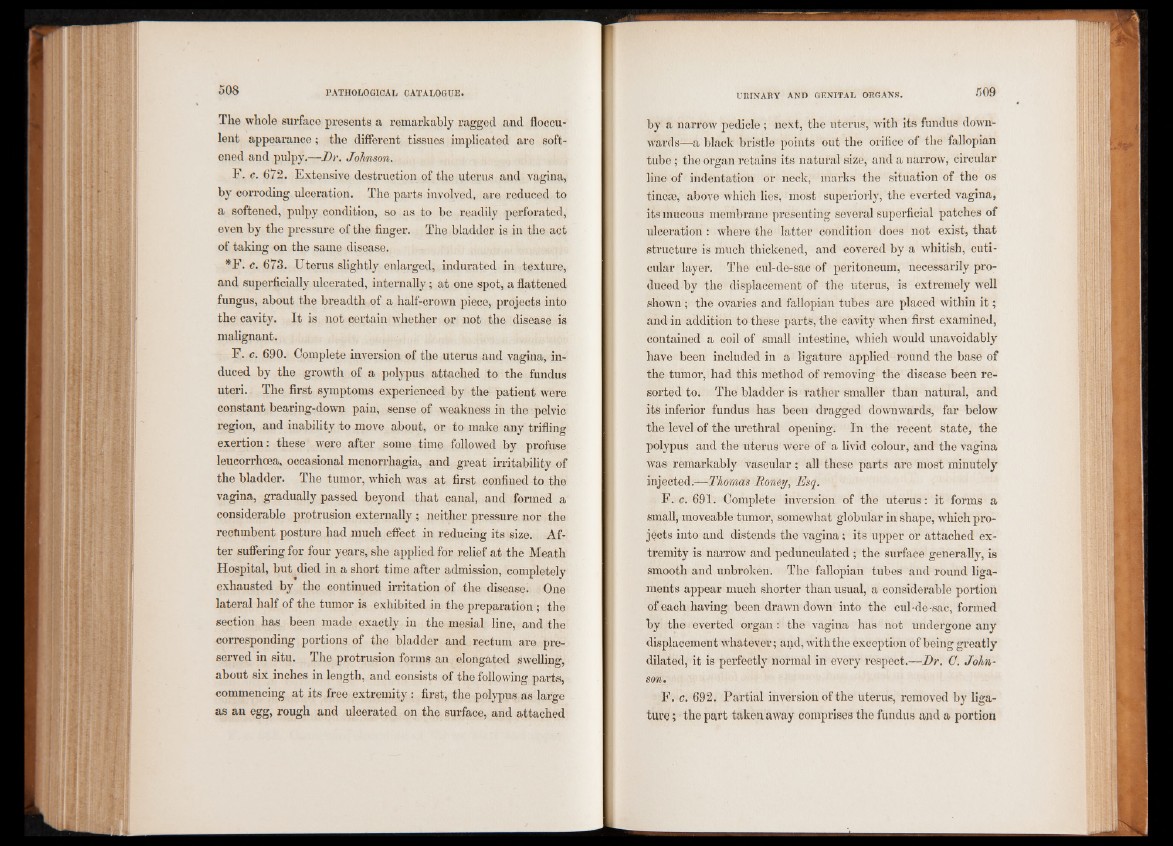
The whole surface presents a remarkably ragged and floccu-
lent appearance; the different tissues implicated are softened
and pulpy.—Dr. Johnson.
F. c. 672. Extensive destruction of the uterus and vagina,
by corroding ulceration. The parts involved, are reduced to
a softened, pulpy condition, so as to be readily perforated,
even by the pressure of the finger. The bladder is in the act
of taking on the same disease.
*F. c. 673. Uterus slightly enlarged, indurated in texture,
and superficially ulcerated, internally; at one spot, a flattened
fungus, about the breadth of a half-crown piece, projects into
the cavity. It is not certain whether or not the disease is
malignant.
F. c. 690. Complete inversion of the uterus and vagina, induced
by the growth of a polypus attached to the fundus
uteri. The first symptoms experienced by the patient were
constant bearing-down pain, sense of weakness in the pelvic
region, and inability to move about, or to make any trifling
exertion: these were after some time followed by profuse
leucorrhcea, occasional menorrhagia, and great irritability of
the bladder. The tumor, which was at first confined to the
vagina, gradually passed beyond that canal, and formed a
considerable protrusion externally ; neither pressure nor the
recfimbent posture had much effect in reducing its size. After
suffering for four years, she applied for relief at the Meath
Hospital, but died in a short time after admission, completely
exhausted by the continued irritation of the diseased One
lateral half of the tumor is exhibited in the preparation ; the
section has been made exactly in the mesial line, and the
corresponding portions of the bladder and rectum are preserved
in situ. The protrusion forms an elongated swelling,
about six inches in length, and consists of the following parts,
commencing at its free extremity : first, the polypus as large
as an egg, rough and ulcerated on the surface, and attached
by a narrow pedicle ; next, the uterus, with its fundus downwards—
a black bristle points out the orifice of the fallopian
tube; the organ retains its natural size, and a narrow, circular
line of indentation or neck, marks the situation of the os
tincse, above which lies, most superiorly, the everted vagina,
its mucous membrane presenting several superficial patches of
ulceration : where the latter condition does not exist, that
structure is much thickened, and covered by a whitish, cuti-
cular layer. The cul-de-sac of peritoneum, necessarily produced
by the displacement of the uterus, is extremely well
shown; the ovaries and fallopian tubes are placed within it;
and in addition to these parts, the cavity when first examined,
contained a coil of small intestine, which would unavoidably
have been included in a ligature applied round the base of
the tumor, had this method of removing the disease been resorted
to. The bladder is rather smaller than natural, and
its inferior fundus has been dragged downwards, far below
the level of the urethral opening. In the recent state, the
polypus and the uterus were of a livid colour, and the vagina
was remarkably vascular; all these parts are most minutely
injected.—Thomas Roney, Esq.
F. c. 691. Complete inversion of the uterus: it forms a
small, moveable tumor, somewhat globular in shape, which projects
into and distends the vagina; its upper or attached extremity
is narrow and pedunculated ; the surface generally, is
smooth and unbroken. The fallopian tubes and round ligaments
appear much shorter than usual, a considerable portion
of each having been drawn down into the cul-de-sac, formed
by the everted organ: the vagina has not undergone any
displacement whatever; and, with the exception of being greatly
dilated, it is perfectly normal in every respect.—Dr. C. Johnson
.F
. c. 692. Partial inversion of the uterus, removed by ligature
; the part taken away comprises the fundus and a portion